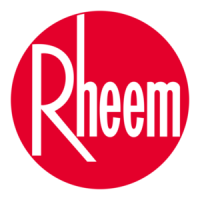24
80+ HIGH ALTITUDE
INSTRUCTIONS
(TABLES 6 & 9)
INSTALLATION OF THIS FURNACE
AT ALTITUDES ABOVE 2000 FT (610
m) SHALL BE IN ACCORDANCE
WITH LOCAL CODES, OR IN THE
ABSENCE OF LOCAL CODES, THE
NATIONAL FUEL GAS CODE, ANSI
Z223.1/NFPA 54 OR NATIONAL
STANDARD OF CANADA, NATURAL
GAS AND PROPANE INSTALLATION
CODE, CAN B149.1.
34" 80 Plus furnaces installed above
2,000 ft. require the furnace to be de-
rated 4% per thousand feet.
IMPORTANT:
Factory installed orifices
are calculated and sized based on a
sea level Natural Gas heating value of
1075 BTU per cubic ft.
NOTE: Orifices are available through
your local distributor.
Reference Tables 6 and 9 for
appropriate orifice sizing.
The following are examples of orifice
sizing using the National Fuel Gas Code
Appendix F:
For a simplified estimation of orifice size
based on gas heating value and
elevation, Tables 6 and 9 may be used.
However, calculations are the best
method.
Example: 900 BTU/ft
3
Regional
Natural Gas Heating Value
I/H = Q
25000 / 900 = 27.78 ft
3
I = Sea Level input (per burner): 25000
H = Sea Level Heating Value: 900
Q = 27.78 ft
3
Natural Gas per hour.
From Table F.1 of
National Fuel Gas
Code Handbook, 2002
(3.5ⴖ w.c.
column).
Orifice required at Sea Level: #40
From Table F.4 of
National Fuel Gas
Code Handbook, 2002
Orifice required at 5000 ft. elevation (4%
de-rate per thousand ft): #42
Orifice required at 8000 ft. elevation (4%
de-rate per thousand ft.): #44
Example: 1050 BTU/ft3 Regional
Natural Gas Heating Value
I / H = Q
25000 / 1050 = 23.81ft
3
I = Sea Level input (per burner): 25000
H = Sea Level Heating Value: 1050
Q = 23.81 ft
3
Natural Gas per hour.
From Table F.1 of
Natural Fuel Gas
Code Handbook, 2002
(3.5⬙ w.c.
column).
Orifice required at Sea Level: #43
From Table F.4 of
National Fuel Gas
Code Handbook, 2002
Orifice required at 5000 ft. elevation
(4% de-rate per thousand ft.): #45
Orifice required at 8000 ft elevation (4%
de-rate per thousand ft): #47
LP GAS (TABLE 7)
NOTE: Keep any parts removed during
LP conversion procedure stored with
the product literature for future use.
LP Gas is a manufactured gas that has
consistent heating value across most
regions.
The NFGC guidelines are used with the
following exception:
The recommended LP Gas high
altitude orifice selections differ slightly
in that the NFGC LP orifice chart, as
they are not accurate for Rheem
products. The National Fuel Gas Code
LP orifices are based on an 11" of
water column pressure at the orifice,
which differs from products that use 10"
of water column at the orifice. This
difference requires a deviation from the
NFGC orifice size recommendations.
The Sea Level input should still be
reduced by 4% per thousand ft. and the
orifice size must be selected based on
the reduced input in Table 7.
FIGURE 19
MANIFOLD PRESSURE-CHANGE LABEL

